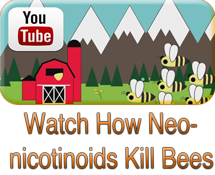A nicotinic acetylcholine receptor agonist affects honey bee sucrose responsiveness and decreases waggle dancing.
Abstract
A nicotinic acetylcholine receptor agonist, imidacloprid, impairs memory formation in honey bees and has general effects on foraging. However, little is known about how this agonist affects two specific aspects of foraging: sucrose responsiveness (SR) and waggle dancing (which recruits nestmates). Using lab and field experiments, we tested the effect of sublethal doses of imidacloprid on (1) bee SR with the proboscis extension response assay, and (2) free-flying foragers visiting and dancing for a sucrose feeder. Bees that ingested imidacloprid (0.21 or 2.16 ng bee(-1)) had higher sucrose response thresholds 1 h after treatment. Foragers that ingested imidacloprid also produced significantly fewer waggle dance circuits (10.5- and 4.5-fold fewer for 50% and 30% sucrose solutions, respectively) 24 h after treatment as compared with controls. However, there was no significant effect of imidacloprid on the sucrose concentrations that foragers collected at a feeder 24 h after treatment. Thus, imidacloprid temporarily increased the minimum sucrose concentration that foragers would accept (short time scale, 1 h after treatment) and reduced waggle dancing (longer time scale, 24 h after treatment). The effect of time suggests different neurological effects of imidacloprid resulting from the parent compound and its metabolites. Waggle dancing can significantly increase colony food intake, and thus a sublethal dose (0.21 ng bee(-1), 24 p.p.b.) of this commonly used pesticide may impair colony fitness.
Eiri DM, Nieh JC. J Exp Biol. 2012 Jun 15;215(Pt 12):2022-9. doi: 10.1242/jeb.068718.

